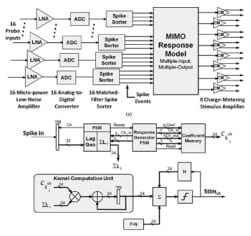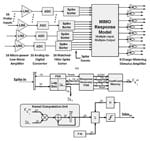A recent publication in the IEEE Transactions on Neural Systems and Rehabilitation Engineering presents the application and hardware fabrication of the multi-input, multi-output (MIMO) nonlinear model for a hippocampal cognitive prosthesis. The modeling results show that the MIMO model can accurate predict the hippocampal CA1 (output) spiking activity based on the ongoing hippocampal CA3 (input) spiking activity and thus restore the lost memory function in rodents.
A Hippocampal Cognitive Prosthesis: Multi-Input, Multi-Output Nonlinear Modeling and VLSI Implementation.
Berger, T.W., Song, D., Chan, R.H.M., Marmarelis, V.Z., LaCoss, J., Wills, J., Hampson, R.E., Deadwyler, S.A. & Granacki, J.J. A Hippocampal Cognitive Prosthesis: Multi-Input,
Multi-Output Nonlinear Modeling and VLSI Implementation. IEEE Transactions on Neural Systems and Rehabilitation Engineering. 20(2): 198-211, 2012.
This paper describes the development of a cognitive prosthesis designed to restore the ability to form new long-term memories typically lost after damage to the hippocampus. The animal model used is delayed nonmatch-to-sample (DNMS) behavior in the rat, and the “core” of the prosthesis is a biomimetic multi-input/multi-output (MIMO) nonlinear model that provides the capability for predicting spatio-temporal spike train output of hippocampus (CA1) based on spatio-temporal spike train inputs recorded presynaptically to CA1 (e.g., CA3). We demonstrate the capability of the MIMO model for highly accurate predictions of CA1 coded memories that can be made on a single-trial basis and in real-time. When hippocampal CA1 function is blocked and long-term memory formation is lost, successful DNMS behavior also is abolished. However, whenMIMO model predictions are used to reinstate CA1 memory-related activity by driving spatio-temporal electrical stimulation of hippocampal output to mimic the patterns of activity observed in control conditions, successful DNMS behavior is restored. We also outline the design in very-large-scale integration for a hardware implementation of a 16-input, 16-output MIMO model, along with spike sorting, amplification, and other functions necessary for a total system, when coupled together with electrode arrays to record extracellularly from populations of hippocampal neurons, that can serve as a cognitive prosthesis in behaving animals.

